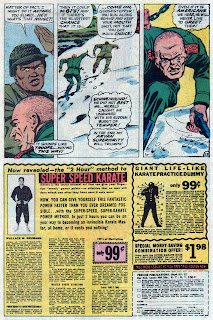Social History in Comics: Sgt. Fury 90 - "The Chain That Binds!"
11:09 AM |
Labels:
African American characters,
Al Kurzrok,
Dick Ayers,
Gabriel Jones,
Marvel,
Racial Integration,
Sgt. Fury and his Howling Commandos,
World War II
This August 1971 issue of Sgt. Fury features an anti-racist story written by Al Kurzrok. Al was a writer for Harvey Comics, and then worked for Marvel mostly as a letterer but did write some 1960s and early 70s stories, including 5 issues of Sgt. Fury. Kurzrok didn't get to pen too many Marvel books. He clearly did his homework on this title, though, because stylistically in many ways it reads like a typical Sgt. Fury book. Although it has an anti-racist message, however, it doesn't deliver this with the same kind of punch that Robert Kanigher or Stan Lee would give a similar story. Given the rarity, even by 1971, of comics taking a stance against racism, it is noteworthy, and should be added to that elite list of anti-racist books. Let's take a look at it. Of course the story highlights Gabriel Jones, and it's another tale, like that in issue 56, that has Gabe on a journey to meet up with the rest of the Howlers. This one starts with him being captured by a Nazi officer on the orders of Hitler himself, who wants to use Gabe as bait in a trap for the rest of the Howling Commandos. Right from the start we're reading racist remarks from the Nazi, and he doesn't let up. The Nazi is motivated by his expectation of considerable reward from the Fuhrer should he succeed in his mission.
As with previous Sgt. Fury anti-racist tales, Southerner Rebel Ralston exhibits the greatest concern for Gabe, continuing the disconfirmation of the 'all southern whites are racists' stereotype that we've seen in anti-racist books in the 50s and 60s.
Gabe meanwhile has to put up with the racist rantings of the Nazi, but handles it well. When their plane gets shot down, they parachute into the snow below. The tables are not quite turned, but circumstances have evened things up a little.
But even Gabe can be pushed too far...
Even though an American patrol passes nearby, Gabe is thwarted in his attempt to get their attention and regain his freedom.
Chained together the two men, complete opposites not because of their respective races but because of their differing world views, continue to battle for the upper hand.
The back and forth dialogue between the Nazi and Gabe has, throughout, exposed the ludicrous yet sinister nature of white supremacist beliefs.
The difference emerges when it becomes clear that the troops they've spotted are American. The Nazi has no qualms about killing Gabe with his knife, and Gabe has to shoot him in order to defend himself. The Nazi's dead after all that, and Gabriel is back with the G.I.'s and will presumably find his way back to the Howlers.
I think this story could have been intended to be allegorical, the chain representing perhaps the institutions in American society that have bound African Americans to racist overlords. If so, then the abrupt ending suggests the racial conflict that had erupted in the Civil Rights era with African Americans pushed to the limit by racist whites unwilling to surrender their assumed superiority. I think that the story seeks, and to some extent succeeds, in ridiculing the racist way of thinking. All that Aryan supremacy stuff. By 1971 people had had enough of their hopes for progress being smashed - assassinations of key leaders, and still no real equality of opportunity in a lot of ways.
Subscribe to:
Post Comments (Atom)




























0 comments:
Post a Comment